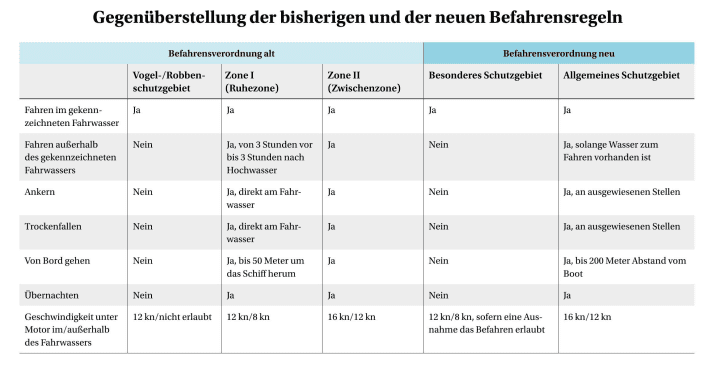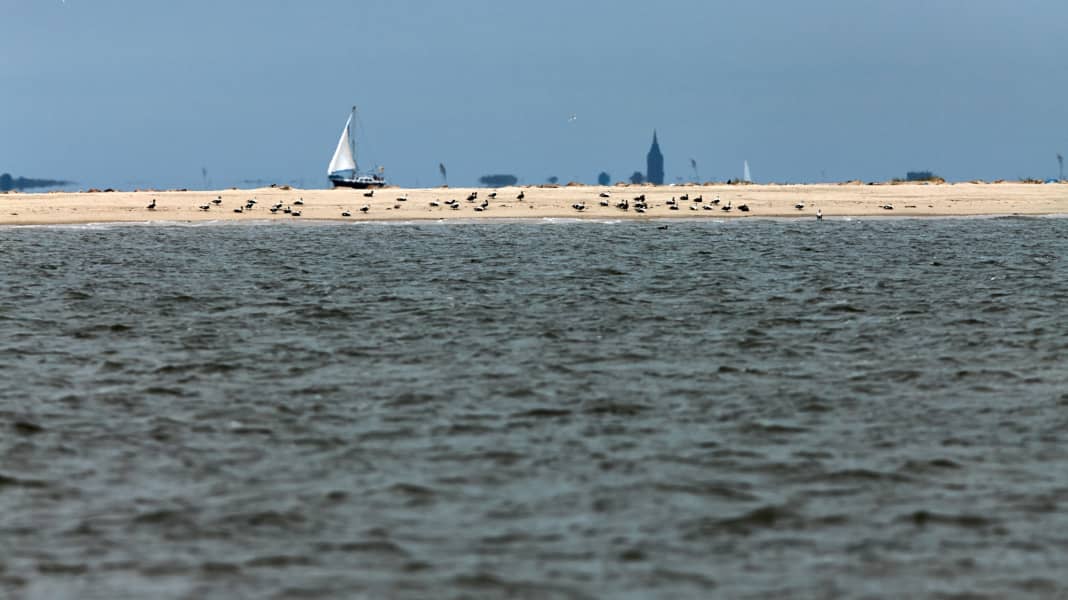
"At the moment we can hardly save ourselves from enquiries!" A certain desperation is evident in the words of Olaf Morgenstern, who, together with other fellow campaigners, founded the website " wattsegler.com ", a popular source of information for Wadden Sea travellers with up-to-date information on the area. "We still have to familiarise ourselves with the situation and are not yet in a position to make a final statement." The "Ordinance on the Navigation of Federal Waterways in National Parks in the North Sea", or North Sea Navigation Ordinance for short, which was issued just in time for the start of the season, is unsettling for many Wadden Sea sailors.
According to the preamble, it regulates "the use of federal waterways in the national parks designated under state law in the North Sea for the protection of nature and landscape and the animal and plant world, in order to contribute to achieving the conservation purposes of these national parks". On five pages, there is a new regulation that brings with it many changes for water sports enthusiasts in the Wadden Sea on the coasts of Lower Saxony, Hamburg and Schleswig-Holstein - and, as is the nature of the law, in a way that seems rather convoluted to the layman. The interpretations and reactions vary accordingly - especially as 15 high-speed corridors allow commercial traffic to transport goods and passengers at a maximum speed of 24 knots. 13 of them are located between Norderelbe and List on Sylt, primarily off the coast of Schleswig-Holstein, from where the majority of offshore wind farms in the North Sea are supplied.
"Massive restrictions" or a good compromise?
The perception of how serious these changes are for sailors is diffuse, to say the least. "The mudflats are no longer barrier-free!" headlines a report from Soltwaters e. V., the organisation representing the interests of mudflat sailors, and speaks of massive restrictions for water sports enthusiasts in the Wadden Sea. "Basically, we are happy with the way things are now. It could have been even worse," says Hans Hüser. The second chairman of the Lower Saxony Sailing Association has been a Wadden Sea sailor for more than 35 years and, like many representatives of clubs and local authorities, has been involved in the development of the navigation ordinance since the Federal Ministry of Transport presented a draft bill in summer 2021 that raised fears of worse consequences for sailors.
Since 2013, various drafts of a new regulation of the navigation ordinance, which has been in place since 1992 and unchanged since 1995, have been under discussion. In the meantime, there was even a threat of a general ban on water sports in the Wadden Sea. The Federal Ministry of Transport justified the need for an amendment on the one hand with changed legal situations and boundaries of the national parks that had not been updated in the nautical charts for a long time, and on the other hand with a new traffic situation on the coasts due to increasing commercial traffic, for example to offshore wind farms; the old regulation had only taken insufficient account of the needs of commercial transport, according to the introduction to the last draft bill.
Tough struggle to preserve what was previously permitted
Since then, the law has been repeatedly discussed, drafted and rejected in various constellations and then given a certain amount of time to mature before the next officer in the Ministry of Transport took up the issue. Against this backdrop, the new regulation came quite suddenly. Representatives of various water sports associations and their interest groups, coastal and island communities, nature conservation organisations and national park administrations were involved in the consultations as part of an association hearing. It was obvious that compromises had to be found in view of the diverging interests. A tough struggle began to preserve what had previously been permitted - in particular sailing across the mudflats and anchoring or falling dry. Not all the objections and suggestions of the Wadden sailors were incorporated into the new regulations.
Why should slow-sailing flat-bottomed vessels be restricted and, on the other hand, taxi boats or offshore supply vessels be allowed a higher speed?"
"It is already striking that the majority of the sites submitted by the local clubs for falling dry have not been considered at all," Olaf Morgenstern also notes after an initial intensive inspection of the navigation regulations. The question as to why this "regulatory monster" only exists for a very small group in the first place is not one he would like to ask. "There will never be a satisfactory answer." Morgenstern is picking up on what many tidal flat sailors and coastal residents affected by the new regulations are criticising: the question of proportionality. In a letter to the Federal Ministry of Transport, Wittmund's mayor Rolf Claußen also commented: "Why should slow-sailing flat-bottomed ships that are part of the landscape be restricted in their use of the Wadden Sea and, on the other hand, taxi boats or offshore suppliers be allowed to travel at higher speeds?"
A lot of voluntary participation meets a lack of expertise
The community of permanent residents in the Carolinensiel museum harbour also asked the ministry when the regulation was drawn up: "Please bear in mind that this regulation mainly affects local, mostly resident mudflat boaters. Their number is manageable. So this is not about mass tourism, but about isolated anchoring or falling dry 50 metres from the already frequented fairway. Further damage to nature is therefore not to be expected."
It was difficult to discuss with people who don't know their way around here at all"
The ministry received comments like these in droves after those affected between Borkum and Sylt had spent countless hours - mostly on a voluntary basis - discussing the 2021 draft bill. "We felt that we were taken seriously, but it was difficult to discuss with people who didn't know anything about the subject," summarises Hans Hüser in retrospect. The sailors described the dangers of the Wadden Sea and explained the wind and current conditions, which can make it necessary to take prohibited routes.
Falling dry in the mudflats only permitted in a few places
However, the new regulation now includes fixed places to fall dry as "exit and staging points": 16 on the west coast of Schleswig-Holstein, six between the Elbe and Weser, four between the Weser and Jade, and eight below the East Frisian Islands. Coordinate-fixed points that may soon be obsolete in view of the morphological changes in the mudflats. "We can't hammer a peg into the mudflats at these points - it could be standing on a sandbank today and be under water the following year," says Hans Hüser, pragmatically concluding: "We'll probably have to move with the sands."
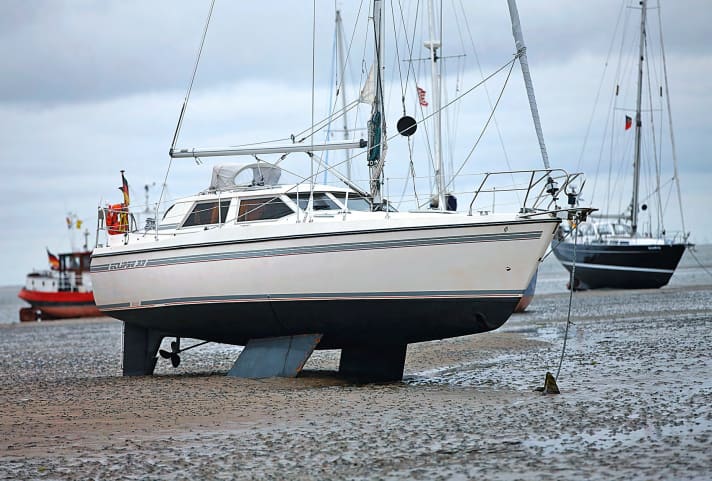
Those involved unanimously regret that the proposal of a "corridor solution", which would have allowed sailors to continue to dry out in the protected areas directly on the fairways and move within 50 metres of the boat, was not adopted; even the law on the Lower Saxony Wadden Sea National Park would have allowed this.
The mudflats are safer for sailors than the traffic zones
From a sailor's point of view, the navigation rules are primarily about safety. This is because the Wadden Sea fairways are used as an alternative to travelling through the coastal traffic zone. "Especially in heavy seas, this route is important for the safety and ease of traffic and is indispensable for the flat-bottomed boats typical of the Wadden Sea. Incidentally, this is not a new realisation, but is based on a traditional shipping route that has formed the backbone of small coastal shipping from the IJsselmeer to the Elbe for centuries," comments the Lower Saxony Sailing Association.
However, the efforts to explain the special features of wind, current and meandering sands to those unfamiliar with the area also led to minor successes. Instead of the initially planned general ban on leaving a boat in the protected areas, the original rule, according to which it was only permitted to move 50 metres away at the permitted locations, has now been extended: "... if this is urgently required for reasons of safety and ease of traffic to ensure the navigability and equipment of the watercraft", it will now be permitted to move up to 200 metres away at the designated dry-fall areas. In addition, in the event of imminent danger to life and limb, it will be possible to deviate from all prohibitions - another result of lengthy discussions.
If you want to behave correctly, you are largely on your own legally, especially when it comes to maps"
The new traffic regulations have also been criticised by conservationists
It is worth noting that conservationists have also criticised the new rules. Nabu President Jörg-Andreas Krüger, for example, describes travelling through the particularly sensitive areas of the national park at low tide as problematic. He appeals to "treat this jewel with appreciation and respect" and, with a view to the overall consequences of the new regulations, also finds clear words in another direction: "Nature conservation has become an accessory. Economic interests are - as so often - in the foreground." The many high-speed motorway corridors, which are not compatible with the high protection status of the Wadden Sea, are particularly serious.
If you want to behave correctly as a sailor, you can follow the codes of conduct from Soltwaters or the regional associations, but for the time being you are largely on your own legally - especially when it comes to chart material. The Federal Ministry of Transport announced in a press release: "The Federal Maritime and Hydrographic Agency will gradually adapt its nautical charts. Until then, the general charts of the North Sea Navigation Ordinance can be used." However, the coarse-format general charts hardly allow for a correct determination.
Before the existing nautical charts are corrected by hand, the season could be over. This is because the regulation is accompanied by a veritable colossus of coordinates: 277 pages showing the boundaries of the protected areas and listing the exceptions, totalling more than 30,000 coordinates. Only four pages list where sailors are still allowed to fall dry and sail on protected area routes. Wadden skippers who want to comply with the law are therefore best advised to orientate themselves on what is permitted. When asked, the BSH is optimistic that it will be able to finalise the official nautical charts as far as possible, at least for next year.
The new rules also have an impact on international cards and driving licence issues
In Chart1/INT1, which lists all internationally recognised symbols and abbreviations, but does not include the terms General and Special Protection Areas, nor the protected area routes or the exceptional places for anchoring and falling dry, no fundamental changes are planned; the cartographers will have to represent the national characteristics of the regulation with the existing symbols and additionally label them in accordance with the regulation. However, private chart publishers are of course free to find their own symbols or labelling.
Recreational boating schools also have to adapt to the new regulations, as the changes also affect the question catalogue for the recreational boating licence. Klaus Schlösser, sailing instructor and member of the textbook editorial team at Delius Klasing Verlag, explains: "Five questions relating to the NordSBefV will change in the sea question catalogue. The change to the question catalogues also has an impact on the textbooks and apps. However, the changes are not that serious, so that in this case the books will probably work with errata slips until the new edition, with the exception of the exercise sheet folders." The new question catalogue for the SBF See is expected to come into force on 1 August 2023, taking into account the current legal changes.
Schlösser has a clear position on the timing of the new regulation coming into force: "The lead time of three months between announcement and entry into force is particularly problematic in the print sector - not only for publishers, but presumably also for the examination organisations. Almost all exam papers have to be replaced - even if only two to four questions change per paper." Nevertheless, the change will not affect the navigation tasks. The 2012 map section will continue to be used.
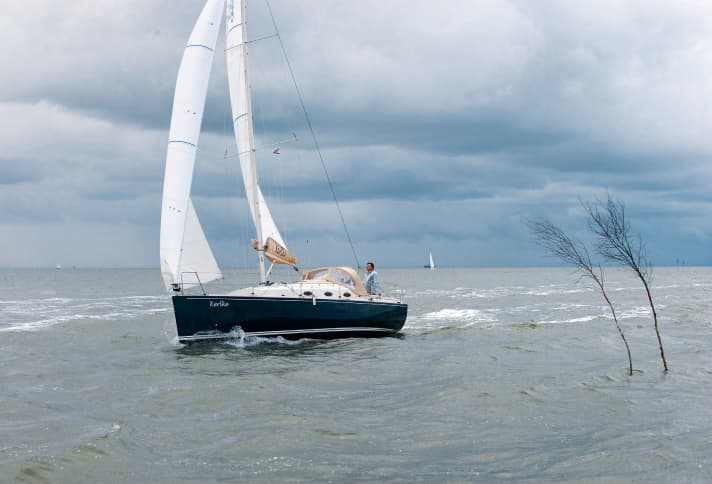
The Netherlands and Denmark have hardly any restrictions
The question remains as to why sailors are seen as such a nuisance in Germany. The Wadden Sea UNESCO World Heritage Site covers an area of around 11,500 square kilometres on the coasts of the Netherlands, Germany and Denmark. However, the new regulations only affect the German coasts. The Trilateral Wadden Sea Sailing Association (TWSSA), an association representing the interests of Wadden Sea sailors in Germany, the Netherlands and Denmark, notes: "The German regulations go very far compared to the Netherlands, where there are restrictions in 10 to 15 per cent of the Wadden Sea, and Denmark, where there are no restrictions." Pieter van Kuppenveld, Chairman of the Dutch Wadden Sea Association Wadvaarders and member of the TWSSA, adds: "Neither here nor in Denmark are there any signs of further restrictions."
The German regulations go very far, in Holland there are only restrictions in 15 per cent of the Wadden Sea, in Denmark there are none at all"
In Germany, meanwhile, discussions are continuing. For example, on the Baltic Sea, where the various nature and bird sanctuaries are to be connected and their protection deepened at the same time. This could result in massive restrictions for water sports. And these are also still on the table for the Wadden Sea: as part of the "Natural Climate Protection Action Programme" (ANK), the Federal Ministry for the Environment is throwing a general sailing ban over seagrass meadows or algae fields into the ring, on which the DSV is already taking a clear stance: "In our view, for example, anchoring and dry-falling bans could be considered to protect seagrass meadows. However, we do not believe that a complete navigation ban, even in shallow water, as is apparently being considered for the Wadden Sea in Lower Saxony, is necessary or proportionate."
At the same time, the "Watt fossil-free" initiative of the nature conservation and research organisation Mellumrat e. V. is working towards the goal set at a Unesco conference in 2010 of making transport in the World Heritage Site carbon-neutral by 2030. In a large-scale project, it is currently examining solutions for fossil-free drives on all watercraft in the Wadden Sea, including pleasure craft. The struggle for compromises will probably continue everywhere.
The new regulations in detail
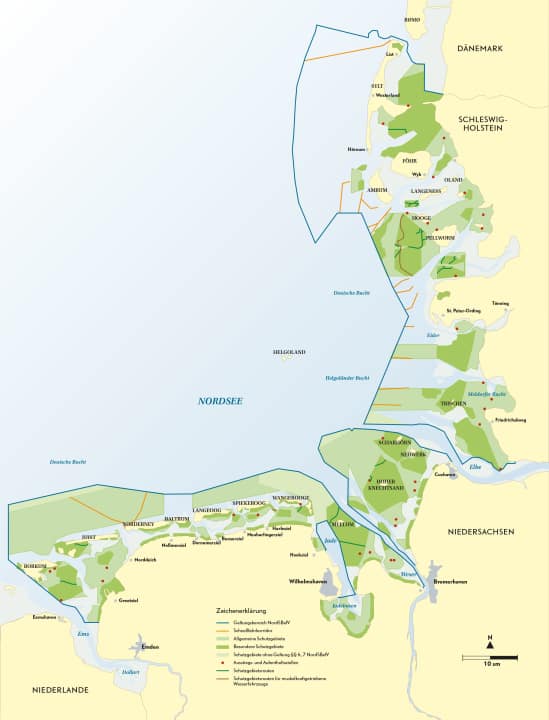
The ordinance abolishes the former seal and bird sanctuaries as well as the quiet zone (Zone I) and the intermediate zone (Zone II) of the Wadden Sea National Park. They will be replaced by "General" and "Special Protection Areas". During the protection periods from 15 April to 1 October, the new Special Protection Areas may only be navigated in the designated fairways.
Whereas sailors were previously allowed to anchor or fall dry in Zone I directly on the fairway and in Zone II in general, this is now only permitted in a few specially designated places. The so-called three-hour rule, according to which Zone I of the national parks could only be navigated in the period from three hours before to three hours after high tide, has been abolished. The fairways of the Special Protection Areas may now be navigated throughout; an adjustment that favours flat-bottomed boats. Some of the traditional routes "across the meadow", which enable a quick trip across the mudflats beyond the Prickenwege even in the protected areas, have been retained. Beyond the protected areas shown on the maps, everything remains the same: Navigation, anchoring and falling dry are still permitted.
